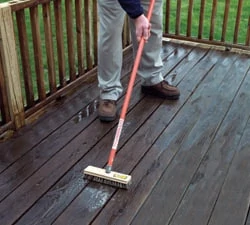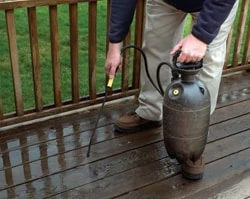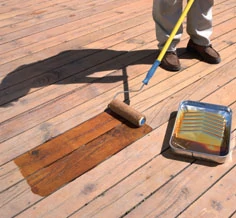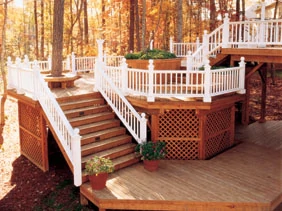By Matt Weber
Choosing the right coating for your deck.
From siding and decking to fences and furniture, homeowners expect a lot from wood. Its one material that can be used for nearly anything related to the home, but requires some tender loving care to keep it looking as good as new. The rule of thumb to protect your exterior wood is to clean and prep the surface, and then go to town with your preservative of choice. However, the wood-finish industry is evolving, and the available products are doing the same. EHT takes a new look at some of the basics of exterior wood care, advances in chemistry and how to get the most from your topcoats.
Prep Steps for Outdoor Coatings
Even though pressure-treated lumber and Western Red Cedar resist insects and decay, they’re still vulnerable to moisture. Moisture can cause the wood to shrink and swell, stressing the fibers. Sealing the surface with a water-repellent finish can help prevent this and preserve wood for years.
The sun is another problem. Like a great cannon in the sky, the sun constantly radiates ultraviolet rays, which gradually damage the wood at a microscopic level. Although clear seal coats are readily available, adding a pigment, such as a wood stain, can help protect the surface from this UV blast and fight the wood’s tendency to turn gray. But just like everything else in life, regular maintenance is critical.
If your deck, fence or pergola is old and gray, the surface has to be prepped before using a new finish. Remove any mildew, dirt, old coatings, etc. The old-fashioned way is to hand-scrub with a stiff synthetic-bristle brush, the most effective but effortful way to prep the wood. Depending on the condition of the wood surface, even sanding is a good idea. However, power-sanding will close the pores of the wood, which can prevent the new stain from penetrating properly. So if you choose to sand, you will have to follow up with a good wash of the deck, which will re-open the pores.

In some cases a chemical stripper is essential for creating an even surface to which the new sealant can adhere. Check in to the new biodegradable strippers that are safer, easier to use and cut down on the harsh fumes of traditional strippers. If the high-traffic areas of your deck have worn down, but there is still sealant remaining in other areas, strip the entire deck before re-staining. Stripping is also important when changing colors. Leftover traces of an old pigment can affect the way a new color appears.

Once the wood is scoured, and stripped if necessary, then apply a deck-cleaning product to brighten the wood. Just follow the directions on the product label. It’s usually a good idea to let the cleaner chemically agitate the surface for a few minutes (don’t let it dry). The deck-cleaning solution may be followed by a pressure washing at 500 PSI—but be careful. Too much pressure can cause the power washer to damage the wood, causing the surface to “fuzz.” Also, use caution to work the nozzle with the grain and never against, which can damage the surface.

Deck-cleaning agents typically fall into three categories: Chlorine Bleach Cleaners are sometimes used, but are not recommended because they can create an unattractive whitewashed appearance. They can also cause of the wood fibers to fuzz. An Oxygen Bleach Cleaner is a better choice. When mixed with water, these products create a hydrogen peroxide and soda ash cleaning base, which is effective in removing mildew stains and the natural graying of the wood surface. The wood also returns to its original color after cleaning, unlike the bleaching associated with chlorine-based products. Oxalic Acid Cleaners are typically used to supplement oxygen bleach cleaners if tannin staining is a problem. Tannins are naturally occurring reddish-brown resins found in redwood, cedar and oak. Oxalic acid also removes rust stains from corroded fasteners, but it won’t touch mildew, so it should be used in conjunction with oxygen bleach.
If your deck is a new construction, then congratulations, you can cut down on the prep work. Although, you should still remove any mill glaze, loose fibers or dirt accumulated during the building phase. Many professionals recommend that new wood is allowed to acclimate to its new environment before staining. The wood needs a chance to release unstable sap, sugars and other residues, which take up space in the wood that the wood coating would otherwise occupy. Thirty days of seasoning is a minimum, but the duration also depends on the wood’s condition when the deck was built, as well as the weather. New, pressure-treated lumber can be very wet, and it needs to be completely dry before staining, especially if using an oil-based product as a coating. Hotter, drier air temperatures will condition the wood quickly, but wet weather will prolong the process. Complete drying of “green” PT wood could potentially take up to six months.
Film-Forming Sealants vs. Penetrating Wood Stains
With prep work complete, it’s time to choose your exterior wood finish. These fall into two major categories, based on how the product bonds to the wood.
A film-forming sealant bonds to the surface of the wood like paint or shellac. This protective film can provide a beautiful high-gloss furniture look, while still allowing the natural woodgrain to show through. These products form a very durable surface that prevents the wood from weathering. However, a high-quality sealant can be expensive, and while they look great, know that they will eventually have to be stripped off if refinishing the wood with a different product. Film-formers include many alkyds, latex-acrylics and varnish resins in oil- or water-based finishes. Pigments are added to the products to change the wood color and add UV protection. Traditionally, these film coatings have been known crack as the wood expands and contracts during normal moisture cycling. However, in recent years technological advances have made great strides toward adding a high degree of flexibility and microporosity in these products, which prevents blistering and cracking. The EHT staff recently used a high-quality film-former, Cetol 1 from Sikkens, to coat some outdoor furniture, and the sealant provided a very handsome satin finish. However, it’s a pricey product at roughly $50 per can and requires three coats to do the trick. Maintenance required for film-forming sealants is usually one coat every 18 months.

The next major category is a penetrating stain with water repellent. Actually, a “water-repellent preservative” is preferred because it has a preservative (mildewcide) that helps control mildew growth. Some products also contain ultraviolet light absorbers, stabilizers or blockers. Penetrating stains are available in both oil-based and water-based formulations. The resins penetrate wood pores to block out the damaging effects of weather while allowing the natural texture to shine through. These finishes offer pigment and protection, but there’s no glossy coat on the penetrating stains.
A current trend among sealant manufacturers is to offer products with a combination of drying and non-drying oils that provides two layers of protection in one product. For example, with Armstrong Clark’s Wood Stains, non-drying conditioning oils penetrate the wood fiber, rejuvenating the wood where the wood’s natural oils used to be. The drying oils stay at the surface and create a matte finish that is dry to the touch.
There are quality products in both the film-forming and penetrating categories and your choice may boil down to personal taste: a glossy furniture-like finish or a more rustic, natural appearance.

Wood Finish: Water vs. Oil
Based on all the questions we get at Extreme How-To, there seems to be a lot of confusion regarding water-based and oil-based finishes.
The science behind the difference in finishes requires a course in chemistry, but in a nutshell it has to do with how the chemical particles of the product bond during the curing phase. Most water-based finishes have tiny particles of pigment and resin that adhere to each other very tightly as the finish dries, similar to a patchwork quilt. With oil-based finishes, the tiny particles actually fuse chemically together into one large sheet-like substance which achieves a harder finish and is less likely to amber. Examine the product’s label for clues to the coating’s quality, keeping an eye out for anything that mentions “non-yellowing” properties.
Water-based finishes are generally heralded for their ease of use. Compared to oil-based formulas, they are easy to clean up, have a lower odor and are often less expensive. However, most water-based coatings require more coats and still don’t last as long before requiring re-application, when compared to their oil-based or “alkyd” counterparts.
Note: You’ll often see “alkyd” written on cans at the paint store. Alkyd coatings are a class of polyester coatings derived from the reaction of an alcohol and an acid or acid anhydride. The term alk-yd is derived from “alcohol and acid, or anhydride” and refers to the dominant resin used in most oil-based coatings.
Although oil-based finishes are usually the more expensive option, the bottom line is that when compared to water-based coatings, the oil-based variety almost always outperforms them. Oil-based coatings provide more long-term, wood-preserving durability.
To complicate this article, I should note some exceptions to this “water versus oil” rule. Some high-quality water-borne products have come a long way in recent years. These advanced water-borne finishes are formulated with water-reducible synthetic resins, and they bond like super glue for much better performance than other water-based finishes. Saver Systems, manufacturer of the Defy-brand wood stain, even offers a product fortified with epoxy resins, which is not a food source for mildew and algae like natural resin (oil-based) stains are.
Color Options
There are four main decorative options for deck finishes: clear, semi-transparent and solid (opaque) in a wide range of colors and tints. Older wood with a more weathered surface might need an opaque stain to cover imperfections. These solid stains are the only variety to hide the grain and will also wear more slowly. However, once they do wear, the damaged finish will be very evident because the natural wood color will show through the otherwise colored finish. The wear from foot traffic is particularly noticeable with a solid stain, making them more suitable for vertical surfaces such as railings and pillars rather than floors and stairs. A combination of colors and tones can create a unique artistic look.
Clear or semi-transparent coatings are popular options, particularly when the wood is new and worthy of showing off. Clear coatings will help protect from moisture and insects, but the wood will still weather to gray beneath the sun’s UV ray exposure. A semi-transparent stain with a UV-blocking pigment will help prevent this while also tinting the surface with a healthy, natural looking tone.
Application
Not all coatings are applied the same way, so follow the instructions on the can. Usually a good oil-based stain can be brushed on, rolled or sprayed. However, most pros would agree that brushing is best because the filaments thoroughly work the finish into the wood grain. Some manufacturers recommend that you “brush back” the stain into the wood grain even if applying it with another method.
The number of coats will also vary. With some coating systems, the overall finished appearance relies on the buildup of successive coats. Other products require only a single base coat, with further coats added to darken the tone. Also, check the label for weather-related instructions. Always avoid wet weather when applying, and most oil-based products should not be applied in direct sunlight.
And lastly, certain specific formulas are intended for specific applications. For example, Log Siding Finish has a different “recipe” than deck finish, typically with higher solids content so it doesn’t require as many coats on the large vertical jobs, like staining a whole house. Siding finish will usually cost considerably more than deck stain. And while deck stain may cost less than siding stain, it may not perform as well for a whole-house application. Those product labels have a purpose. So pay attention, always follow instructions, and remember—you get what you pay for. You will inevitably pay more for a higher quality stain than a cheaper competitor, but in the long run you’ll be glad you did.
VOC Rags and What They Mean
One of the most common terms used in the wood-coatings and solvents industry is “VOC.” The term refers to Volatile Organic Compounds, ingredients in the solvent that contribute to ozone, a common air pollutant that has proven to be a public health hazard. Currently some states such as California impose VOC restrictions on wood finishes, requiring the use of low-VOC products. Some manufacturers offer low-VOC versions of certain products for sell in those particular areas. However, the EPA will eventually impose those same regulations nationwide, so those low-VOC products will become the norm. Low-VOC finishes may contain a higher solids content, non-VOC solvents or water. Most of these new formulations are actually a better product because with more solids in the mix, more finish material stays on the wood surface. The down side is that the products are thicker and usually require brushing them on, which can be a difficult chore on large decks or wood siding. In general the lower the VOC rating, the more solids are found in the products. For example, a coating with a 250 VOC-content rating has 75 percent solids and 25 percent solvent. A coating with a 550 VOC rating has only 33 percent solids and 67 percent solvent.
Exterior Wood Finish Resources
Armstrong-Clark www.armclark.com 1-800-916-8211







